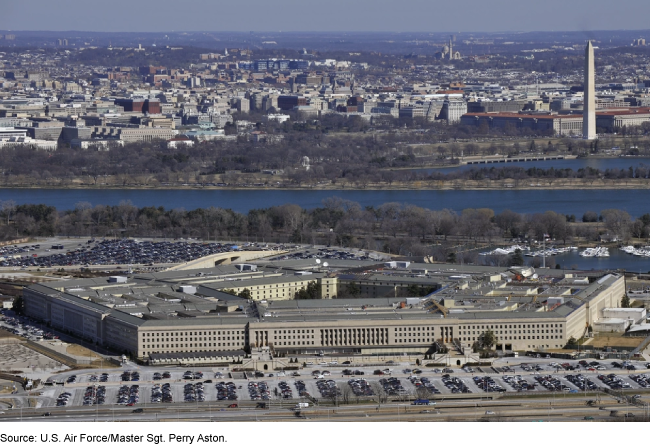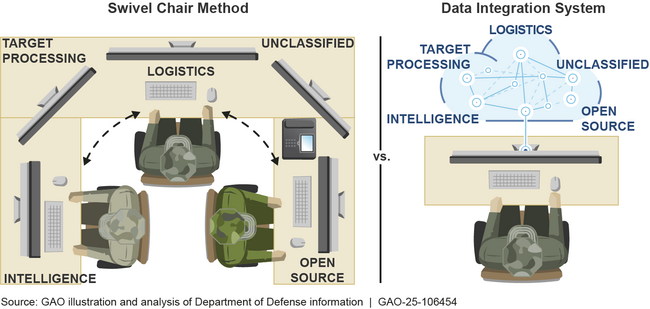Defense Command and Control: Further Progress Hinges on Establishing a Comprehensive Framework
Fast Facts
The Department of Defense is working to help military commanders better analyze and share information in real time. This complex effort is not a singular system and depends on contributions by all military services.
Six years in, the military services are pursuing projects largely in isolation and without clear goals. This approach will likely result in delivering capability much more slowly and inefficiently, if at all. We identified several cross organizational issues that no one is currently addressing.
We made 3 recommendations, including that DOD develop a framework that helps guide investments and measure progress.

Highlights
What GAO Found
Combined Joint All-Domain Command and Control (CJADC2) is a Department of Defense (DOD) concept aimed at improving command and control by connecting selected U.S. assets across space, air, land, sea, and cyberspace domains. CJADC2 also aims to establish connections with international partners. DOD expects that, while difficult, pursuing CJADC2 will enable key decision makers to share and use data to perform command and control operations more quickly and easily. For example, CJADC2 would support a transition from a model where an analyst receives inputs and manually enters data from different systems—referred to as “swivel chair” analysis—to a model where all data is integrated.
Moving from a “Swivel Chair” Model to an Integrated Model

DOD has attempted to define and guide CJADC2 efforts since its inception in 2019. However, it has yet to build a framework that can guide CJADC2-related investments across DOD or track progress toward its goals. As the CJADC2 concept has taken shape, military departments and other DOD entities have concurrently pursued their own independent data integration capabilities. GAO has previously found that establishing measurable goals and then measuring progress against these goals is critical for organizations. In the absence of clear direction, warfighting entities will continue to pursue their command and control projects largely in isolation, which will likely result in achieving CJADC2 much more slowly and inefficiently, if at all.
DOD is conducting activities aimed at demonstrating selected capabilities, but there is limited awareness of experimentation lessons learned that could lead to duplicative efforts and slower progress toward CJADC2 goals. Further, GAO found several critical challenges to achieving CJADC2 that DOD has yet to formally identify and address. For example, overly restrictive data classification is a significant hindrance to sharing command and control data. Further, officials GAO spoke with were not aware of an entity working on a solution to this or several other critical challenges. CJADC2 leadership told GAO that addressing these challenges was beyond their purview. Without identifying and addressing key challenges, DOD's progress toward its CJADC2 objectives will remain limited.
Why GAO Did This Study
Military commanders need to quickly make informed decisions in battle. They rely on DOD systems to transform vast amounts of data into actionable information. DOD established the CJADC2 effort in 2019 to address these needs across domains. CJADC2 is not itself a system but is a way to use data and analytics to make and communicate better decisions in battle.
A House report includes a provision for GAO to review CJADC2 efforts. GAO (1) identifies how DOD defines its concept of CJADC2 and tracks systems, progress, and investments; and (2) assesses the extent to which DOD is positioned to improve command and control data sharing among existing systems and address challenges to developing new data- sharing solutions moving forward.
GAO analyzed policies, planning documents, and briefings related to DOD's goals for CJADC2 and GAO reviewed documents on service-level CJADC2 efforts. GAO interviewed, among others, officials from DOD, the military services, all 11 combatant commands, and the CJADC2 cross functional team.
Recommendations
GAO is recommending that DOD (1) develop a framework for CJADC2 that helps guide investments and measures progress; (2) devise a mechanism for sharing lessons learned; and (3) identify and address key challenges in achieving its CJADC2 goals. DOD concurred with two and partially concurred with one of GAO's recommendations.
Recommendations for Executive Action
| Agency Affected | Recommendation | Status |
|---|---|---|
| Department of Defense | The Secretary of Defense should establish a framework to evaluate the extent to which military organization investments align with and achieve CJADC2 goals. The framework should establish clear guidance for command and control investments and a means to collectively track progress toward CJADC2 goals. (Recommendation 1) |
When we confirm what actions the agency has taken in response to this recommendation, we will provide updated information.
|
| Department of Defense | The Secretary of Defense should establish an approach to consolidate and share lessons learned from ongoing CJADC2-related experimentation and real-world activities to the larger DOD enterprise. (Recommendation 2) |
When we confirm what actions the agency has taken in response to this recommendation, we will provide updated information.
|
| Department of Defense | The Secretary of Defense should identify, comprehensively assess, and address key challenges that hinder progress toward DOD's CJADC2 goals. (Recommendation 3) |
When we confirm what actions the agency has taken in response to this recommendation, we will provide updated information.
|
